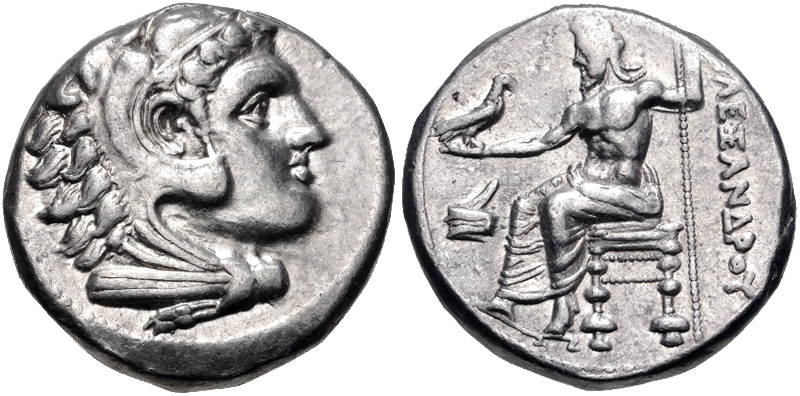Soli (Alexander the Great), silver, tetradrachms (Heracles/seated Zeus) (325-318 BCE)
From SILVER
(Redirected from S 1692 - Soli (Alexander the Great), silver, tetradrachms (325-318 BCE))
325 BC - 318 BCE Silver 4,897 kg
Description
| ObverseInscription or printing placed on the obverse.: | Head of Herakles to right, wearing lion skin headdress |
| ReverseInscription or printing placed on the reverse.: | AΛEΞANΔPOY (Greek).Zeus seated left on low throne, holding long scepter in his left hand and eagle standing right with closed wings in his right, to left, prow, below throne, Z |
Mint and issuing power
| MintIdentifies the place of manufacture or issue of a numismatic object.: | Soli (Cyprus) | Ancient regionAncient region.: | Cyprus | Modern countryModern country: Greece | AuthorityIdentifies the issuing power. The authority can be "pretended" when the name or the portrait of X is on the coin but he/she was not the issuing power. It can also be "uncertain" when there is no mention of X on the coin but he/she was the issuing power according to the historical sources: | Alexander III the Great (Argead king, 336-323 BC), Macedonian kingdom |
Chronology
| FromIdentifies the initial date in a range assigned in a numismatic context. | 325 BC | toIdentifies the final date in a range assigned in a numismatic context.. | 318 BCE | PeriodTime period of the numismatic object.: Hellenistic 323-30 BC |
Physical description
| MetalThe physical material (usually metal) from which an object is made.: | Silver |
Median weightMedian of the weights of numismatic objects (in grams). in grams | 17.10 | DenominationTerm indicating the value of a numismatic object. Examples: tetradrachm, chalkous, denarius.: | tetradrachm |
StandardStandard.: | Attic |
Image

S1692 Soli tetradrachms.jpg [1]
References
| Die study referencePublication of the study: | Troxell 19981Troxell 1998 | ||
| Coin series referenceReference to coin series study: | Price 19912Price 1991, n° 3190 | ||
| Coin series web referenceCoin series web references: | |||
Obverse dies distribution
no distribution is available
Reverse dies distribution
no distribution is available
Quantification
| Number of obversesNumber of obverse dies. ᵖ (o) | 13 | Number of singletons (o1)The number of singleton coins. ᵖ | |
| Number of reverse diesNumber of reverse dies. (r) | 39 | Number of coinsNumber of coins. (n) | 68 |
| Coins per obverse dieNumber of coins per obverse die. (n/o) | 5.23 | Coins per reverse dieNumber of coins per reverse die. (n/r) | 1.74 |
| Reverse per obverse ratioRatio of obverse dies divided by reverse dies. (r/o) | 3 | Percentage of singletons (o1)number of coins (n) divided by the number of singletons (o1) ᵖ | % |
| Original number of dies (O) (Carter 1983 formula)The estimation of the number of coins according to Carter 1983 ᵖ | 14.32 | Coins struck if 20,000 as average productivity per dieCoins made if the average productivity for obverses (according to Carter) is 20,000. ᵖ | 286,400 |
| Original number of dies (O) (Esty 2011 formula)The estimation of the number of coins according to the singleton formula in Esty 2011 ᵖ (O) | 16.07 | Survival rate if 20,000 as average productivity per dieSurvival rate if average productivity is 20,000. ᵖ | 0.00024 |
| Coverage (o = % of O) (Esty 1984 formula)Esty 1984 - coverage (% of O) ᵖ (o = % of O) | % | Die productivity if survival rate 1/2,000Average productivity if survival rate is 1/2,000. ᵖ | 9,497.21 |
| Weight of silver (in kg) if 20,000 coins per die (O = Carter formula)Carter 1983 * Median weight * 20000 (*10 if gold or electrum) ᵖ | 4,897 kg <br /> 4,897 kg | Die productivity if survival rate 1/5,000Average productivity if survival rate is 1/5,000. ᵖ | 23,743.02 |
Remarks
Most likely one single workstation Certainly military
References
- ^ Troxell, Hyla (1998), "Alexanders from Soli on Cyprus", in Richard Ashton and Silvia Hurter (eds.), Studies in Greek Numismatics in Memory of Martin Jessop Price, London, p. 339-344
- ^ Price, Martin Jessop (1991), The Coinage in the Name of Alexander the Great and Philip Arrhidaeus: a British Museum Catalogue, 2 vol., Zürich-London, 637 p., 637 p., clix pl.